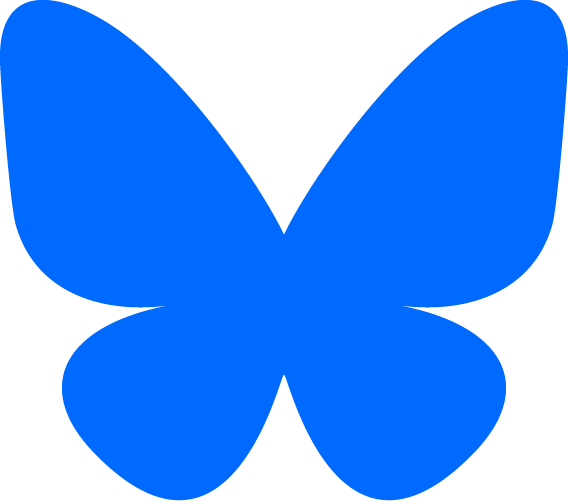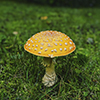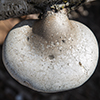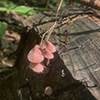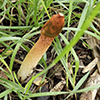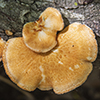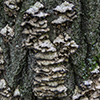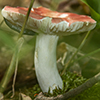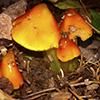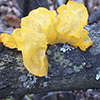Minnesota Fungi
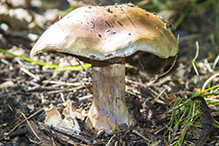
Kingdom Fungi
Fungi is the kingdom of living organisms that is characterized by lacking chlorophyll, feeding on dead and decaying organic matter, producing spores, and having cells with cell walls that contain chitin. The order includes mushrooms, puffballs, rusts, smuts, sac fungi, molds, yeasts, Penicillium, bread molds, and organisms that cause plant and animal diseases such as athlete’s foot and leaf spot.
While there are about 100,000 described fungi species, there are estimated to be over 1,500,000 species worldwide. According to the Bell Museum of Natural History, there are 9,000 species expected to be native to Minnesota “based on the number of vascular plant species native to the state and the ratio of fungi to vascular plants for well documented parts of Europe.”
To date, only eight states have declared a state mushroom. In 1984, the Minnesota legislature designated the Yellow Morel (Morchella esculentoides) as the state mushroom of Minnesota.
Recent research based on DNA comparisons have resulted in changes in taxonomic order at all levels, even the highest. Fungi are now considered to be closer to animals than plants. As a result, authoritative sources of information about fungi on the Web sometimes provide different binomial names and lineages for the same species.
What is the difference between a mushroom and a toadstool?
A mushroom is a fleshy fruiting body of a fungus, consisting of a dome-shaped or flat cap on a stalk, with spore-bearing gills or pores on the underside of the cap. The word “toadstool” is a nonscientific term. In common usage the term “mushroom” refers to an edible mushroom and the term “toadstool” refers to a poisonous mushroom.
Recent Additions
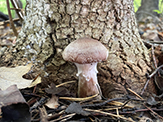
In the early 1990s a huge underground mycelium of Bulbous Honey Fungus (Armillaria gallica) was found covering 37 acres in the Upper Peninsula of Michigan. Molecular genetics showed the underground part of the fungus (mycelium) to be about 1,500 years old. It came to be known as the “Humongous Fungus”, became a popular tourist attraction, and spawned a annual fungus festival. At the time of its discovery it was thought to be the largest organism on earth, a title formerly held by Pando, the quaking aspen grove in Utah. Since that time, three other organisms have held that title. The current (2022) holder is the marine plant Posidonia australis in Shark Bay, Australia.
Bulbous Honey Fungus is a common, late season, gilled mushroom occurring in Europe, Asia, and North America. It appears in late summer and fall growing on the ground attached to underground roots, on stumps and logs, and on the base of living trees.
The mature cap is broadly convex to almost flat, pinkish-brown or brownish-yellow, and covered with slender fibers. The stalk is thick and expanded at the bottom, appearing club-shaped. The flesh is edible when cooked and has a mild to bitter taste.

Ruby Bolete (Hortiboletus rubellus) is a small, red capped, blue staining mushroom. It occurs in Europe, the United States, southern Canada, and Mexico. It reaches the western extent of one part of its range in eastern Minnesota. It is found in summer and fall in woodlands, parks, and gardens. It grows on the ground near oaks and other hardwood trees.
The cap is small, no more than 2⅜″ in diameter, and is bright but dark pinkish-red. This is the feature that gives the mushroom its common name. It often has a thin yellow or whitish band around the margin. The pore surface on the underside of the cap is yellow. It quickly stains dark blue when bruised. The stalk is up to 2¾″ long, is mostly red, and has many tiny red dots. When cut lengthwise, the flesh of the stem reveals numerous, tiny, bright red or carrot orange dots near the base.
Ruby Bolete is edible but it has a soapy taste, and like other boletes, it is often infested with maggots.
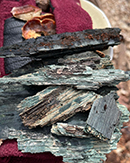
There are between 100 and 250 species of sap staining fungi, and they are divided into three groups. One of these groups is known as blue stain fungi. It is an informal grouping of various species of sac fungi (Ascomycota) that cause blue discoloration in the heartwood of trees without destroying the wood. The fungi are from the genera Ceratocystis, Ophiostoma, Ceratocystiopsis, and Grosmannia. They do not form a single taxonomic group because they do not descend from a common ancestor. Not all species in those genera cause blue staining.
Blue stain fungi spores are carried to a living tree on the body of a wood boring beetle. Their thread-like cells (hyphae) produce dark melanin on their walls to protect them from light, drought, and the tree’s own defenses. Blue discoloration spreads from the wound on the outside through the heartwood in a wedge-shaped pattern following the spread of the fungus. Boxelder trees produce a brilliant red stain in the wood as a response to the fungus.
Blue stain fungi damages the living tree by clogging the vascular system, leading to decline and premature death of the tree. The damage caused to the wood is merely aesthetic. The discoloration makes the wood undesirable and less profitable but does not weaken the wood.
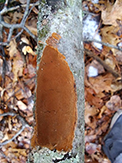
Elbowpatch Crust (Fomitiporia punctata) is one of many fungi that cause a disease known as canker rot. Cankers are open wounds or lesions on the trunk or a branch. With this species, the canker is takes the form of a brown “elbow patch.” It spreads flat on the surface of the substrate with no stalk or cap (resupinate). The outer (pore) surface is yellowish-brown or grayish-brown. The margins are yellowish-brown at first, eventually becoming black and cracked.
Elbowpatch Crust is a common and widespread wood decaying fungus. It occurs worldwide on every continent except Antarctica. In North America it occurs east of the Great Plains and in the Pacific Northwest. It is found in deciduous and mixed forests and woodlands. It grows on many hardwood trees and shrubs, including willow, ash, maple, plum, buckthorn, mountain ash, Siberian peashrub, and common lilac. It is usually seen on fallen trees and branches, but will also grow on live trees and shrubs. It causes white rot of sapwood and in some species also of heartwood. It can weaken a tree making it a hazard to buildings and people.
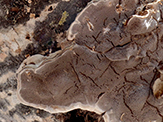
Mossy Maze Polypore (Cerrena unicolor) is a widespread and very common bracket fungi. It occurs in Europe and Asia, and throughout North and Central America. In the United States it is common east of the Great Plains, uncommon in the Pacific northwest, and absent elsewhere. In Minnesota it is very common in the eastern half of the state, uncommon to absent in the western half. It is found year round in deciduous and mixed forests, on dead hardwood stumps and logs.
When growing on the underside of a log it looks like a pore surface that has lost its cap. When on the top or side of a log or stump it produces a semi-circular shelf-like or bracket-like cap. The upper surface is whitish to brownish or dark brown, but is often green due to a covering of algae. It has a broad pale margin and is densely hairy, sometimes velvety.
The pore surface is whitish when young, becoming smoky gray at maturity. The pores are slotted, maze-like. The flesh is leathery, tough and inedible.
Other Recent Additions
This list includes only fungi that have been recorded in Minnesota, but not all of the fungi found in Minnesota.
| A | |||||
|---|---|---|---|---|---|
| Profile | Photo | Video | |||
|
|
|||||
Alder Bracket (Xanthoporia radiata) |
|||||
Almond Woodwax (Hygrophorus agathosmus) |
|||||
Almond-scented Russula (Russula fragrantissima) |
|||||
Almond-scented Russula (Russula grata) |
|||||
Almost Bluing King Bolete (Boletus subcaerulescens) |
|||||
Amanita Mold (Hypomyces hyalinus) |
|||||
Amber Jelly Fungus (Exidia recisa) |
|||||
America Saffron Ringless Amanita (Amanita pseudocrocea) |
|||||
American Yellow Fly Agaric (Amanita muscaria var. guessowii) |
|||||
American Matsutake (Tricholoma magnivelare) |
|||||
Angels Wings (Pleurocybella porrigens) |
|||||
Apricot Jelly fungus (Tremiscus helvelloides) |
|||||
Arched Earthstar (Geastrum fornicatum) |
|||||
Arched Woodwax (Hygrophorus camarophyllus) |
|||||
Ash Heart Rot (Perenniporia fraxinophila) |
|||||
Ash Rust (Puccinia sparganioidis) |
|||||
Ashen Chanterelle (Cantharellus cinereus) |
|||||
Ashen Knight (Tricholoma virgatum) |
|||||
Ash-tree Bolete (Boletinellus merulioides) |
|||||
Ash-tree Bolete (Gyrodon merulioides) |
|||||
Aspen Oyster Mushroom (Pleurotus populinus) |
|||||
| B | |||||
|---|---|---|---|---|---|
| Profile | Photo | Video | |||
|
|
|||||
Barley Powdery Mildew (Blumeria graminis) |
|||||
Bay Cup (Legaliana badia) |
|||||
Bay Polypore (Picipes badius) |
|||||
Beaked Earthstar (Geastrum pectinatum) |
|||||
Bear Lentinus (Lentinellus ursinus) |
|||||
Bearded Fieldcap (Agrocybe molesta) |
|||||
Beech Mushroom (Hypsizygus elongatipes) |
|||||
Beech Mushroom (Hypsizygus tessulatus) |
|||||
Beech Rooter (Hymenopellis furfuracea) |
|||||
Beefsteak False Morel (Discina fastigiata) |
|||||
Beefsteak Polypore (Fistulina hepatica) |
|||||
Benzoin Bracket (Ischnoderma benzoinum) |
|||||
Benzoin Bracket (Ischnoderma benzoinum) |
|||||
Bicolored Bracket (Gloeoporus dichrous) |
|||||
Bicolored Russula (Russula bicolor) |
|||||
Bicoloured Bracket (Vitreoporus dichrous) |
|||||
Birch Brittlegill (Russula betularum) |
|||||
Birch Jelly (Exidia repanda) |
|||||
Birch Knight (Tricholoma fulvum) |
|||||
Birch Milkcap (Lactarius tabidus) |
|||||
Birch Witch’s-Broom (Taphrina betulina) |
|||||
Bitter Bolete (Tylopilus felleus) |
|||||
Bitter Tooth (Hydnellum scabrosum) |
|||||
Bitter Waxcap (Hygrocybe mucronella) |
|||||
Black Cherry Rust (Tranzschelia arthurii) |
|||||
Black Morel (Morchella elata) |
|||||
Black Tooth (Phellodon niger) |
|||||
Blackberry Orange Rust (Arthuriomyces peckianus) |
|||||
Blackedged Shield (Pluteus atromarginatus) |
|||||
Blackening Brittlegill (Russula nigricans) |
|||||
Blackfoot Polypore (Cerioporus leptocephalus) |
|||||
Blackish-red Russula (Russula vinacea) |
|||||
Bleached Brittlegill (Russula exalbicans) |
|||||
Bleeding Bonnet (Mycena sanguinolenta) |
|||||
Bleeding Oak Crust (Stereum gausapatum) |
|||||
Blonde, Hairy Inocybe (Inocybe mixtilis) |
|||||
Blood Red Russula (Russula rosacea) |
|||||
Bloody Brittlegill (Russula sanguinaria) |
|||||
Blotched Woodwax (Hygrophorus erubescens) |
|||||
Blue Chanterelle (Polyozellus multiplex) |
|||||
Blue Cheese Polypore (Tyromyces caesius) |
|||||
Blue Edge Pinkgill (Entoloma serrulatum) |
|||||
Blue Spot Knight (Tricholoma columbetta) |
|||||
Blue-green Cracking Russula (Russula parvovirescens) |
|||||
Blushing False Truffle (Rhizopogon rubescens) |
|||||
Blushing Milkcap (Lactarius controversus) |
|||||
Blushing Wood Mushroom (Agaricus haemorrhoidarius) |
|||||
Bog Shadow (Arrhenia umbratilis) |
|||||
Bolete (Boletus nobilissimus) |
|||||
bolete (Gyrodon intermedius) |
|||||
bolete (Leccinum flavostipitatum) |
|||||
bolete (Octaviania spp.) |
|||||
bolete (Tylopilus spp.) |
|||||
boletes (Boletellus spp.) |
|||||
bonnet (Mycena flavifolia) |
|||||
Bouillon Bolete (Lanmaoa pallidorosea) |
|||||
Bracket Fungi (Family Polyporaceae) |
|||||
bracket fungus (Datronia stereoides) |
|||||
bracket fungus (Datroniella scutellata) |
|||||
bracket fungus (Vanderbylia robiniophila) |
|||||
bracket polypore (Climacocystis borealis) |
|||||
bracket polypore (Rhodofomes carneus) |
|||||
Brain Puffball (Calvatia craniiformis) |
|||||
Brittle Cinder (Kretzschmaria deusta) |
|||||
brittlegill (Russula amoenicolor) |
|||||
brittlegill (Russula aurata) |
|||||
brittlegill (Russula californiensis) |
|||||
brittlegill (Russula cerolens) |
|||||
brittlegill (Russula cinerascens) |
|||||
brittlegill (Russula flavisiccans) |
|||||
brittlegill (Russula foetentula) |
|||||
brittlegill (Russula fuscorubroides) |
|||||
brittlegill (Russula galochroa) |
|||||
brittlegill (Russula michiganensis) |
|||||
brittlegill (Russula pulverulenta) |
|||||
brittlegill (Russula romagnesiana) |
|||||
brittlegill (Russula squalida) |
|||||
brittlegill (Russula ventricosipes) |
|||||
brittlegill (Russula viridella) |
|||||
brittlestem (Psathyrella cystidiosa) |
|||||
brittlestem (Psathyrella rhodospora) |
|||||
brittlestem (Russula flavisiccans) |
|||||
Brown American Star-footed Amanita (Amanita brunnescens) |
|||||
Brown Beech Mushroom (Hypsizygus tessellatus) |
|||||
Brown Goblet (Arrhenia epichysium) |
|||||
Brownflesh Bracket (Coriolopsis gallica) |
|||||
Brown-staining Cheese Polypore (Fuscopostia fragilis) |
|||||
Brown-toothed Crust Fungus (Hydnoporia olivacea) |
|||||
Bug Sputnik (Ophiocordyceps clavulata) |
|||||
Bulbous Fiber Cap (Inocybe napipes) |
|||||
Butterball (Suillus weaverae) |
|||||
Butternut Canker (Sirococcus clavigignenti-juglandacearum) |
| C | |||||
|---|---|---|---|---|---|
| Profile | Photo | Video | |||
Camembert Brittlegill (Russula amoenolens) |
|
||||
Canker Rot (Phellinus everhartii) |
|||||
Cankers (Cytospora spp.) |
|||||
Catkin Cup (Ciboria batschiana) |
|||||
cavalier (Melanoleuca davisiae) |
|||||
Cedar-quince Rust (Gymnosporangium clavipes) |
|||||
Celandine Lactarius (Lactarius chelidonium) |
|||||
Ceramic Parchment (Xylobolus frustulatus) |
|||||
Ceratocystis Canker of Bitternut Hickory (Ceratocystis smalleyi) |
|||||
Cercospora Leaf Spot of Roses (Rosisphaerella rosicola) |
|||||
Changeable False Morel (Gyromitra ambigua) |
|||||
Charcoal Burner (Russula cyanoxantha) |
|||||
Charcoal Scalycap (Pholiota carbonaria) |
|||||
Cherry Leaf Spot (Blumeriella jaapii) |
|||||
Chestnut Bolete (Gyroporus castaneus) |
|||||
Chicken Lips (Leotia viscosa) |
|||||
Chocolate Milky (Lactarius lignyotus) |
|||||
Chrome-footed Bolete (Harrya chromapes) |
|||||
Cinnamon Bracket (Hapalopilus nidulans) |
|||||
Clay Waxycap (Hygrophorus discoideus) |
|||||
Clouded Funnel (Clitocybe nebularis) |
|||||
Cluster Cap (Connopus acervatus) |
|||||
Clustered Bonnet (Mycena inclinata) |
|||||
Clustered Clitocybe (Lepista subconnexa) |
|||||
Cobweb Parasol (Lepiota cortinarius) |
|||||
coincap (Clitocybula familia) |
|||||
Coker’s Lavender Staining Amanita (Amanita lavendula) |
|||||
Collared Earthstar (Geastrum triplex) |
|||||
Common Conecap (Conocybe tenera) |
|||||
Common Earthball (Scleroderma citrinum) |
|||||
Common Fieldcap (Agrocybe pediades) |
|||||
Common Funnel (Infundibulicybe gibba) |
|||||
Common Grey Disco (Mollisia cinerea) |
|||||
Common Jellyspot (Dacrymyces stillatus) |
|||||
Common Mazegill (Datronia mollis) |
|||||
Common Milkcap (Lactarius fuliginellus) |
|||||
Common Milkcaps (Lactarius spp.) |
|||||
Common Mycena (Mycena vulgaris) |
|||||
conecap (Conocybe macrocephala) |
|||||
conecap (Conocybe siennophylla) |
|||||
Confusing Bolete (Strobilomyces confusus) |
|||||
Conical Brittlestem (Parasola conopilus) |
|||||
Conifer Mazegill (Gloeophyllum sepiarium) |
|||||
Conifer Pinwheel (Pseudomarasmius pallidocephalus) |
|||||
Conifer Woodtuft (Kuehneromyces vernalis) |
|||||
Copper Brittlegill (Russula decolorans) |
|||||
Copper Spike (Chroogomphus rutilus) |
|||||
coral fungus (Ramaria foetida) |
|||||
coral fungus (Ramaria pusilla) |
|||||
coral fungus (Ramaria rubella) |
|||||
coral fungus (Ramaria rubiginosa) |
|||||
Coral-pink Merulius (Phlebia incarnata) |
|||||
Corky Bark Disease (Diplodia tumefaciens) |
|||||
Corona Cup (Plectania melastoma) |
|||||
Cowboy’s Handkerchief (Hygrophorus eburneus var. eburneus) |
|||||
Cowboy’s Handkerchief (Hygrophorus eburneus) |
|||||
Cramp Balls (Annulohypoxylon thouarsianum) |
|||||
Crimped Gill (Plicaturopsis crispa) |
|||||
Cross-veined Troop Mushroom (Xeromphalina kauffmanii) |
|||||
Crowded Brittlegill (Russula densifolia) |
|||||
Crown Fungus (Sarcosphaera crassa) |
|||||
Crowned Earthstar (Geastrum coronatum) |
|||||
Crystal Brain Fungus (Myxarium nucleatum) |
|||||
cup fungi (Family Pezizaceae) |
|||||
Curry Bolete (Boletus sensibilis) |
|||||
Cytospora Canker (Valsa sordida) |
| D | |||||
|---|---|---|---|---|---|
| Profile | Photo | Video | |||
Daisy Earthstar (Geastrum floriforme) |
|||||
Dapper Funnel (Infundibulicybe trulliformis) |
|||||
Dark Dapperling (Lepiota atrodisca) |
|||||
Dark Fieldcap (Cyclocybe erebia) |
|||||
Dark-stalked Bolete (Leccinum atrostipitatum) |
|||||
Dead Man’s Foot (Pisolithus tinctorius) |
|||||
Dead Moll’s Fingers (Xylaria longipes) |
|||||
Deadly Galerina (Galerina autumnalis) |
|||||
Deadly Inocybe (Inocybe rimosa) |
|||||
Deadly Parasol (Lepiota josserandii) |
|||||
Death Cap (Amanita phalloides) |
|||||
Deep Root Mushroom (Hymenopellis radicata) |
|||||
Depressed Hedgehog (Hydnum umbilicatum |
|||||
Dingy Twiglet (Simocybe centunculus) |
|||||
Dirty Milky (Lactarius sordidus) |
|||||
Dog Stinkhorn (Mutinus caninus) |
|||||
Dog’s Nose Fungus (Camarops petersii) |
|||||
Dogwood Golden Canker (Aurantioporthe corni) |
|||||
domecap (Lyophyllum konradianum) |
|||||
downy mildew (Plasmopara halstedii) |
|||||
Downy Mildew of Impatiens (Plasmopara obducens) |
|||||
Downy Milk Cap (Lactarius pubescens) |
|||||
Drumstick Truffleclub (Tolypocladium capitatum) |
|||||
Dung Roundhead (Protostropharia semiglobata) |
|||||
Dung-loving Bird’s Nest (Cyathus stercoreus) |
|||||
|
|||||
|
|||||
|
|||||
|
|||||
|
|||||
|
|||||
|
|||||
|
| E | |||||
|---|---|---|---|---|---|
| Profile | Photo | Video | |||
Early Morel (Verpa bohemica) |
|||||
earthball (Scleroderma michiganense) |
|||||
Earthstars (Geastrum spp.) |
|||||
Eastern American Jack-o’-Lantern Mushroom (Omphalotus illudens) |
|||||
Eastern North American Destroying Angel (Amanita bisporigera) |
|||||
Elfin Saddle (Helvella lacunosa) |
|||||
Emetic Russula (Russula silvicola) |
|||||
Eutypella Canker (Eutypella parasitica) |
|||||
|
|||||
|
|||||
|
|||||
|
|||||
|
|||||
|
|||||
|
|||||
|
|||||
|
|||||
|
|||||
|
|||||
|
|||||
|
| F | |||||
|---|---|---|---|---|---|
| Profile | Photo | Video | |||
Faba Bean Rust (Uromyces viciae-fabae) |
|
||||
Fairly False Funnelcap (Leucopaxillus laterarius) |
|||||
Fairy Ring Marasmius (Marasmius oreades) |
|||||
False Matsutake (Tricholoma caligatum) |
|||||
false morrel (Gyromitra ambigua) |
|||||
false morrel (Gyromitra fastigiata) |
|||||
Felt Saddle Fungus (Helvella macropus) |
|||||
fiber cap (Inocybe fuscomarginata) |
|||||
fiber cap (Inocybe heterochrominea) |
|||||
fiber cap (Inocybe hirtella) |
|||||
fiber cap (Inocybe nitidiuscula) |
|||||
fiber cap (Inocybe nodulospora) |
|||||
fiber cap (Inocybe subcarpta) |
|||||
Fire Blight (Erwinia amylovora) |
|||||
Fire-milk Lactarius (Lactarius pyrogalus) |
|||||
Firerug Inkcap (Coprinellus domesticus) |
|||||
Fishbiscuit Russula (Russula compacta) |
|||||
Flat Crep (Crepidotus applanatus) |
|||||
Flat-bulb Mushroom (Agaricus abruptibulbus) |
|||||
Fleecy Fibercap (Inocybe flocculosa) |
|||||
Fleecy Milky Cap (Lactarius subvellereus) |
|||||
Fluted Bird’s Nest (Crucibulum striatus) |
|||||
Fluted Bird's Nest Fungus (Cyathus striatus) |
|||||
Fluted White Elfin Saddle (Helvella crispa) |
|||||
Fool’s Conecap (Conocybe filaris) |
|||||
Four-rayed Earthstar (Geastrum quadrifidum) |
|||||
Foxy Bolete (Leccinum vulpinum) |
|||||
Fragile Brittlegill (Russula fragilis) |
|||||
Fragrant Black Trumpet (Craterellus foetidus) |
|||||
Fragrant Inocybe (Inocybe pyriodora) |
|||||
Freckled Dapperling (Lepiota aspera) |
|||||
Frost’s Amanita (Amanita frostiana) |
|||||
Frosty funnel (Leucocybe candicans) |
|||||
Funeral Bell (Galerina marginata) |
|||||
fungi (Bolbitius spp.) |
|||||
fungi (Camarops spp.) |
|||||
fungi (Clavaria spp.) |
|||||
fungi (Clitopilus spp.) |
|||||
fungi (Dendrostilbella spp.) |
|||||
fungi (Diatrype spp.) |
|||||
fungi (Eudarluca spp.) |
|||||
fungi (Family Agaricaceae) |
|||||
fungi (Family Pleurotaceae) |
|||||
fungi (Family Sclerotiniaceae) |
|||||
fungi (Family Tremellaceae) |
|||||
fungi (Glomus spp.) |
|||||
fungi (Heterotextus spp.) |
|||||
fungi (Hysterangium spp.) |
|||||
fungi (Nectria spp.) |
|||||
fungi (Phaeomarasmius spp.) |
|||||
fungi (Rhizopogon spp.) |
|||||
fungi (Sepedonium spp.) |
|||||
fungi (Simocybe spp.) |
|||||
fungi (Steccherinum spp.) |
|||||
fungi (Stephanoma spp.) |
|||||
fungus (Ascobolus denudatus) |
|||||
fungus (Ascobolus furfuraceus) |
|||||
fungus (Ascobolus viridis) |
|||||
fungus (Chionosphaera apobasidialis) |
|||||
fungus (Cystodermella terryi) |
|||||
fungus (Dacrymyces minor) |
|||||
fungus (Genabea spinospora) |
|||||
fungus (Gibellula pulchra) |
|||||
fungus (Gloiodon strigosus) |
|||||
fungus (Granulobasidium vellereum) |
|||||
fungus (Gymnopus semihirtipes) |
|||||
fungus (Hohenbuehelia nigra) |
|||||
fungus (Hymenoscyphus calyculus) |
|||||
fungus (Hypomyces macrosporus) |
|||||
fungus (Hypomyces purpureus) |
|||||
fungus (Inocutis rheades) |
|||||
fungus (Inosperma adaequatum) |
|||||
fungus (Laeticutis cristata) |
|||||
fungus (Lentaria byssiseda) |
|||||
fungus (Lepiota lilacea) |
|||||
fungus (Lepiota neophana) |
|||||
fungus (Leptonia strictipes) |
|||||
fungus (Marasmius capillaris) |
|||||
fungus (Marchandiomyces corallinus) |
|||||
fungus (Melanomma subdispersum) |
|||||
fungus (Melanomma subdispersum) |
|||||
fungus (Mollisia ligni) |
|||||
fungus (Narcissea patouillardii) |
|||||
fungus (Neolentinus cyathiformis) |
|||||
fungus (Neottiella vivida) |
|||||
fungus (Ophiocordyceps stylophora) |
|||||
fungus (Orbilia auricolor) |
|||||
fungus (Orbilia luteorubella) |
|||||
fungus (Paecilomyces penicillatus) |
|||||
fungus (Phellinopsis conchata) |
|||||
fungus (Phellinus populicola) |
|||||
fungus (Pleuroflammula multifolia) |
|||||
fungus (Pulvinula convexella) |
|||||
fungus (Ramariopsis asterella) |
|||||
fungus (Resinomycena rhododendri) |
|||||
fungus (Resupinatus dealbatus) |
|||||
fungus (Xylaria cubensis) |
|||||
fungus (Xylaria filiformis) |
|||||
funnel (Hertzogia martiorum) |
|||||
Fused Polypore (Albatrellus confluens) |
|||||
| G | |||||
|---|---|---|---|---|---|
| Profile | Photo | Video | |||
Gassy Knight (Tricholoma inamoenum) |
|||||
Gem-Studded Amanita (Amanita gemmata) |
|||||
Ghost Chanterelle (Cantharellus phasmatis) |
|||||
Ghost Shield (Pluteus pellitus) |
|||||
Giant Lentinus (Neolentinus ponderosus) |
|||||
Girdled Webcap (Cortinarius trivialis) |
|||||
Goblet Waxcap (Hygrocybe cantharellus) |
|||||
Golden Cap (Cystoderma aureum) |
|||||
Golden Coincap (Cyptotrama chrysopepla) |
|||||
Golden Ear (Tremella aurantia) |
|||||
Golden Gilled Bolete (Phylloporus rhodoxanthus) |
|||||
Golden Waxy Cap (Hygrocybe flavescens) |
|||||
Goldenhaired Inkcap (Parasola auricoma) |
|||||
Goldenrod Rust (Coleosporium solidaginis) |
|||||
Granular Puffball (Arachnion album) |
|||||
Greasy Green Brittlegill (Russula heterophylla) |
|||||
Green Beetle Hanger (Hesperomyces virescens) |
|||||
Green Brittlegill (Russula aeruginea) |
|||||
Green Mould of Narcissus (Trichoderma viride) |
|||||
Green Quilt Russula (Russula crustosa) |
|||||
Green’s Polypore (Coltricia montagnei) |
|||||
Greenfoot Webcap (Cortinarius glaucopus) |
|||||
Green-tipped Coral (Ramaria apiculata var. apiculata) |
|||||
Green-tipped Coral (Ramaria apiculata var. brunnea) |
|||||
Grey Bolete (Retiboletus griseus) |
|||||
Grey Tooth (Phellodon melaleucus) |
|||||
Greylings (Tephrocybe spp.) |
|||||
Grey-veiled Amanita (Amanita porphyria) |
|||||
|
|||||
|
|||||
|
|||||
|
|||||
|
| H | |||||
|---|---|---|---|---|---|
| Profile | Photo | Video | |||
Hairy Earth Tongues (Trichoglossum spp.) |
|||||
Hairy Leg Bell (Galerina vittiformis) |
|||||
Hairy Milkcap (Lactarius villosus) |
|||||
Hairy-stalked Collybia (Gymnopus spongiosus) |
|||||
Hedgehog Mushrooms (Hydnum spp.) |
|||||
Hemlock Varnish Shelf (Ganoderma tsugae) |
|||||
Hollyhock Rust (Puccinia malvacearum) |
|||||
Honey Pinkgill (Entoloma cetratum) |
|||||
honeycomb fungus (Favolus pseudobetulinus) |
|||||
Hooded False Morel (Gyromitra infula) |
|||||
Horn of Plenty (Craterellus cornucopioides) |
|||||
|
|||||
|
|||||
|
|||||
|
|||||
|
|||||
|
|||||
|
|||||
|
|||||
|
|||||
|
|||||
|
|||||
|
| I | |||||
|---|---|---|---|---|---|
| Profile | Photo | Video | |||
inkcap (Coprinopsis coniophora) |
|||||
Ivory Funnel (Collybia dealbata) |
| J | |||||
|---|---|---|---|---|---|
| Profile | Photo | Video | |||
Jelly Tree Ear (Auricularia americana) |
|||||
|
|||||
|
|||||
|
|||||
|
|||||
|
| K | |||||
|---|---|---|---|---|---|
| Profile | Photo | Video | |||
Kauffmans stumpfoot mushroom (Crepidotus kauffmanii) |
|||||
Kindred Milk Cap (Lactarius affinis var affinis) |
|||||
Kindred Milk Cap (Lactarius affinis) |
|||||
knight (Melanoleuca resplendens) |
|||||
knight (Tricholoma argenteum) |
|||||
knight (Tricholoma mutabile) |
|||||
knight (Tricholoma odorum) |
|||||
knight (Tricholoma olivaceobrunneum) |
|||||
knight (Tricholoma subresplendens) |
|||||
knight (Tricholoma transmutans) |
| L | |||||
|---|---|---|---|---|---|
| Profile | Photo | Video | |||
Lacquered Bracket (Ganoderma lucidum) |
|||||
Larch Spike (Gomphidius maculatus) |
|||||
Layered Cup (Peziza varia) |
|||||
Leaf Parachute (Marasmius epiphyllus) |
|||||
Leaf Spot (Cerospora xanthoxyli) |
|||||
Leaf Spot of Hemp Dogbane (Stagonospora apocyni) |
|||||
Lesser Rooting Xerula (Hymenopellis megalospora) |
|||||
Lilac Bonnet (Mycena pura) |
|||||
Lilac Oysterling (Panus conchatus) |
|||||
Lion’s Mane (Hericium erinaceus) |
|||||
Liver Milkcap (Lactarius hepaticus) |
|||||
Liverwort Navel (Loreleia postii) |
|||||
Lizard’s Claw Mushroom (Lysurus cruciatus) |
|||||
Longspored Orange Coral (Ramaria longispora) |
|||||
Loose Smut (Ustilago syntherismae) |
|||||
Lumpy Bracket (Trametes gibbosa) |
|||||
Lurid Bolete (Boletus luridus) |
|||||
Lurid Bolete (Suillellus luridus) |
| M | |||||
|---|---|---|---|---|---|
| Profile | Photo | Video | |||
|
|
|||||
Matt Knight (Tricholoma imbricatum) |
|||||
Mayapple Rust (Allodus podophylli) |
|||||
Meadow Mushroom (Agaricus campestris) |
|||||
Mealy Tooth (Hydnellum ferrugineum) |
|||||
Midwestern Yellow Chanterelle (Cantharellus flavus) |
|||||
milk cap (Lactarius maculatus) |
|||||
milk cap (Lactarius nancyae) |
|||||
Milk-white Brittlegill (Russula delica) |
|||||
milkcap (Lactarius glutigriseus) |
|||||
milkcap (Lactarius pseudodeceptivus) |
|||||
milkcap (Lactarius pseudoflexuosus) |
|||||
milkcap (Lactarius pseudouvidus) |
|||||
milkcap (Lactarius splendens) |
|||||
Milky Bonnet (Hemimycena lactea) |
|||||
Milky Pea Truffle (Jimgerdemannia lactiflua) |
|||||
Modest Russula (Russula modesta) |
|||||
Mottlegills (Panaeolus spp.) |
|||||
Mouse-pee Pinkgill (Entoloma incanum) |
|||||
Mower’s Mushroom (Panaeolus foenisecii) |
|||||
Mulch Fieldcap (Agrocybe putaminum) |
|||||
Mushroom Pimples Fungus (Hypomyces microspermus) |
|||||
Mushrooms, Bracket Fungi, Puffballs, and Allies (Class Agaricomycetes) |
|||||
Mustard Yellow Polypore (Fuscoporia gilva) |
|||||
Mycosphaerella Leaf Spot (Mycosphoerello effiguroto) |
| N | |||||
|---|---|---|---|---|---|
| Profile | Photo | Video | |||
Necklace Tricholoma (Tricholoma focale) |
|||||
Netted Fieldcap (Bolbitius reticulatus) |
|||||
Newfoundland Chanterelle (Cantharellus enelensis) |
|||||
Noble Bolete (Boletus nobilis) |
|||||
Northern Red Belt (Fomitopsis mounceae) |
|||||
Northern Russula (Russula borealis) |
|||||
Nut Disco (Hymenoscyphus fructigenus) |
| O | |||||
|---|---|---|---|---|---|
| Profile | Photo | Video | |||
|
|
|||||
Oak Mazegill (Daedalea quercina) |
|||||
Oak Wilt (Ceratocystis fagacearum) |
|||||
Oakbug Milkcap (Lactarius quietus) |
|||||
Oak-loving Gymnopus (Gymnopus dryophilus) |
|||||
Ochre Bracket (Trametes ochracea) |
|||||
Ochre Brittlegill (Russula ochroleuca) |
|||||
Ochre Spreading Tooth (Steccherinum ochraceum) |
|||||
Olive Pine Spike (Chroogomphus ochraceus) |
|||||
Onion-stalk Parasol (Leucocoprinus cepistipes) |
|||||
Orange Bonnet (Mycena acicula) |
|||||
Orange Earthtongue (Microglossum rufum) |
|||||
Orange Eyelash Cup (Scutellinia erinaceus) |
|||||
Orange Grisette (Amanita crocea) |
|||||
Orange Jelly Spot (Dacrymyces chrysospermus) |
|||||
Orange Pinwheel (Marasmius siccus) |
|||||
Orange Rough-cap Tooth (Hydnellum aurantiacum) |
|||||
Orange Rust (Gymnoconia nitens) |
|||||
Orange Rust of Raspberries (Gymnoconia interstitialis) |
|||||
Orange Webcap (Cortinarius mucosus) |
|||||
Orange-gilled Waxy Cap (Humidicutis marginata var. marginata) |
|||||
Orange-yellow Marasmius (Marasmius strictipes) |
|||||
orange-yellow rust (Aecidium impatientis) |
|||||
orange-yellow rust (Puccinia eatoniae) |
|||||
orange-yellow rust (Puccinia longipes var. brevipes) |
|||||
orange-yellow rust (Puccinia silphii) |
|||||
Oyster Mushrooms (Pleurotus spp.) |
|||||
Oyster Rollrim (Tapinella panuoides) |
|||||
oysterling (Crepidotus albatus) |
|||||
oysterling (Crepidotus luteicolor) |
|||||
oysterling (Crepidotus regularis) |
| P | |||||
|---|---|---|---|---|---|
| Profile | Photo | Video | |||
|
|
|||||
Pale Brittlestem (Candolleomyces candolleanus) |
|||||
Pallid Bolete (Imleria pallida) |
|||||
Panther Cap (Amanita pantherina var. pantherina) |
|||||
parachute (Collybiopsis subnuda) |
|||||
Patrician Deer Mushroom (Pluteus petasatus) |
|||||
Peach-colored Fly Agaric (Amanita persicina) |
|||||
Pelargonium Webcap (Cortinarius paleaceus) |
|||||
Pendulous-disc Polypore (Porodisculus pendulus) |
|||||
Petticoat Mottlegill (Panaeolus papilionaceus) |
|||||
Phyllosticta Leaf Spot (Mycosphoerello fraxinicola) |
|||||
Pig’s Ears (Gomphus clavatus) |
|||||
pin mold (Spinellus spp.) |
|||||
Pine Bracket (Porodaedalea pini) |
|||||
Pinelitter Gingertail (Xeromphalina cauticinalis) |
|||||
Pine-oak Gall Rust (Cronartium quercuum) |
|||||
pinkgill (Entoloma infula) |
|||||
pinkgill (Entoloma majaloides) |
|||||
pinkgill (Entoloma parvum) |
|||||
Pinkgills (Entoloma spp.) |
|||||
Pinkish-orange Pholiota (Pholiota astragalina) |
|||||
pinwheel or parachute mushroom (Gloiocephala caricis) |
|||||
pinwheels (Crinipellis spp.) |
|||||
Pleated Inkcap (Parasola plicatilis) |
|||||
Pleated Pluteus (Pluteus longistriatus) |
|||||
poisonpie (Hebeloma colvini) |
|||||
Poisonpie (Hebeloma dunense) |
|||||
Poplar Bracket (Rigidoporus populinus) |
|||||
Powder-scale Pholiota (Flammulaster erinaceellus) |
|||||
powdery mildew (Erysiphe diffusa) |
|||||
Powdery Mildew (Order Erysiphales) |
|||||
Powdery Mildew (Phyllactinia guttata) |
|||||
Pretty Pinkgill (Entoloma formosum) |
|||||
Primrose Brittlegill (Russula sardonia) |
|||||
Puffball Parasol (Chlorophyllum agaricoides) |
|||||
Puffballs (Family Lycoperdaceae) |
|||||
Purple Spindles (Alloclavaria purpurea) |
|||||
Purple Swamp Brittlegill (Russula nitida) |
|||||
Purplepore Bracket (Trichaptum abietinum) |
|||||
Purple-edge Bonnet (Mycena purpureofusca) |
|||||
Purple-staining Bearded Milk Cap (Lactarius repraesentaneus) |
|||||
Purslane White Rust (Wilsoniana portulacae) |
| Q | |||||
|---|---|---|---|---|---|
| Profile | Photo | Video | |||
|
| R | |||||
|---|---|---|---|---|---|
| Profile | Photo | Video | |||
Rare Spring Sedge Smut (Schizonella melanogramma) |
|
||||
Ravenel’s Red Stinkhorn (Mutinus ravenelii) |
|||||
Red Chanterelle (Cantharellus cinnabarinus) |
|||||
Red Saucer (Melastiza chateri) |
|||||
Redhead Russula (Russula rhodocephala) |
|||||
Red-banded Webcap (Cortinarius armillatus) |
|||||
Red-gilled Psathyrella (Psathyrella conissans) |
|||||
Ringed Cone Head (Pholiotina rugosa) |
|||||
Ringed Tubaria (Tubaria confragosa) |
|||||
Robust Clitocybe (Clitocybe robusta) |
|||||
Rooting Polypore (Polyporus radicatus) |
|||||
Rose Bracket (Rhodofomes roseus) |
|||||
Rosy Conk (Rhodofomes cajanderi) |
|||||
Rosy Woodwax (Hygrophorus pudorinus) |
|||||
Rounded Earthstar (Geastrum saccatum) |
|||||
Ruby Dapperling (Leucoagaricus rubrotinctus) |
|||||
Ruddy Puffball (Lycoperdon subincarnatum) |
|||||
Russet Scaly Tricholoma (Tricholoma vaccinum) |
|||||
Russula-like Amanita (Amanita russuloides) |
|||||
rust fungus (Gymnoconia spp.) |
|||||
rust fungus (Melampsora bigelowii) |
|||||
rust fungus (Phragmidium americanum) |
|||||
rust fungus (Phragmidium ivesiae) |
|||||
rust fungus (Phragmidium potentillae) |
|||||
rust fungus (Puccinia polygoni-amphibii var. convolvuli) |
|||||
rust fungus (Tranzschelia pruni-spinosae var. americana) |
|||||
rust fungus (Uromyces acuminatus) |
|||||
rust fungus (Uromyces asclepiadis) |
|||||
rust fungus (Uromyces glycyrrhizae) |
|||||
rust fungus (Uromyces halstedii) |
|||||
rust fungus (Uromyces seditiosus) |
|||||
rust fungus (Uromyces spp.) |
|||||
rust fungus (Uropyxis amorphae) |
|||||
Rusty Gilled Polypore (Gloeophyllum sepiarium) |
|||||
Rusty Porecrust (Fuscoporia ferruginosa) |
|||||
Rusty Woodwart (Hypoxylon rubiginosum) |
| S | |||||
|---|---|---|---|---|---|
| Profile | Photo | Video | |||
Saffron Crep (Crepidotus crocophyllus) |
|
||||
Salmon Amanita (Amanita wellsii) |
|||||
Sandy Laccaria (Laccaria trullisata) |
|||||
Scaly Chanterelle (Turbinellus floccosus) |
|||||
Scaly Rustgill (Gymnopilus sapineus) |
|||||
Scaly Webcap (Cortinarius pholideus) |
|||||
scalycap (Pholiota granulosa) |
|||||
scalycap (Pholiota mixta) |
|||||
Scarlet Bonnet (Atheniella adonis) |
|||||
Scurfy Twiglet (Tubaria furfuracea) |
|||||
Septoria Leaf Spot (Septoria aceris) |
|||||
Sessile Earthstar (Geastrum fimbriatum) |
|||||
Shaggy Pholiota (Pholiota squarrosa) |
|||||
shelf fungi (Merulius spp.) |
|||||
shelf fungus (Climacodon sp.) |
|||||
shelf fungus (Diplomitoporus crustulinus) |
|||||
shelf fungus (Trametopsis cervina) |
|||||
Shellfish-scented Russula (Russula xerampelina) |
|||||
Shield Dapperling (Lepiota clypeolaria) |
|||||
Shiny Cinnamon Polypore (Coltricia cinnamomea) |
|||||
Shoehorn Oyster Mushroom (Hohenbuehelia petaloides) |
|||||
Shooting Star (Sphaerobolus stellatus) |
|||||
Silky Parchment (Stereum striatum) |
|||||
Silver-blue Milkcap (Lactarius paradoxus) |
|||||
Slender Roundhead (Leratiomyces squamosus var. thraustus) |
|||||
Slimy Milk Cap (Lactarius mucidus) |
|||||
Slimy Spike (Gomphidius glutinosus) |
|||||
slippery jack (Suillus borealis) |
|||||
Slippery Jack (Suillus luteus) |
|||||
slippery jack (Suillus spp.) |
|||||
Slippery White Bolete (Suillus placidus) |
|||||
Small Funnel-Veil Amanita (Amanita multisquamosa) |
|||||
Small White Crepidotus (Crepidotus ellipsoideus) |
|||||
Small Yellow Russula (Russula lutea) |
|||||
Smoky-gilled Hypholoma (Hypholoma capnoides) |
|||||
Smooth Chanterelle (Cantharellus lateritius) |
|||||
Smooth Patch (Aleurodiscus oakesii) |
|||||
Smoothish-stemmed Bolete (Hemileccinum subglabripes) |
|||||
Snaketongue Truffleclub (Tolypocladium ophioglossoides) |
|||||
Snell’s Bolete (Leccinum snellii) |
|||||
Soft Puffball (Lycoperdon molle) |
|||||
Sooty Hygrophorus (Hygrophorus fuligineus) |
|||||
Sour Cap Suillus (Suillus acidus) |
|||||
Spectacular Chanterelle (Cantharellus spectaculus) |
|||||
spike (Gomphidius flavipes) |
|||||
spike (Gomphidius nigricans) |
|||||
Spiny Puffball (Lycoperdon echinatum) |
|||||
Split Fibrecap (Pseudosperma rimosum) |
|||||
Spotted Collybia (Rhodocollybia maculata) |
|||||
Spotted Milkcap (Lactarius scrobiculatus) |
|||||
Spring Beauty Rust (Puccinia mariae-wilsoniae) |
|||||
Spring Fieldcap (Agrocybe praecox) |
|||||
Spring Polypore (Polyporus arcularius) |
|||||
Spruce Waxy Cap (Hygrophorus piceae) |
|||||
Stalked Hairy Cup (Helvella chinensis) |
|||||
Stalked Lentinellus (Lentinellus micheneri) |
|||||
Stalked Orange Peel Fungus (Sowerbyella rhenana) |
|||||
Stalked Puffball (Tulostoma simulans) |
|||||
Stalked Rosette (Cotylidia undulata) |
|||||
Stalked Stereum (Cotylidia diaphana) |
|||||
Star Fibercap (Inocybe asterospora) |
|||||
Stem Canker (Diplodia natalensis) |
|||||
Sticky Gray Trich (Tricholoma portentosum) |
|||||
Stinkhorns (Family Phallaceae) |
|||||
Stinking Brittlegill (Russula foetens) |
|||||
Stinking Dapperling (Lepiota cristata) |
|||||
Streaked Clitocybe (Pseudoarmillariella ectypoides) |
|||||
Striate Earthstar (Geastrum striatum) |
|||||
Stripe Smut of Rye (Urocystis occulta) |
|||||
Sulphur Knight (Tricholoma sulphureum) |
|||||
Sulphur Milkcap (Lactarius tabidus) |
|||||
Summer Bonnet (Mycena abramsii) |
|||||
Swamp Beacons (Mitrula spp.) |
|||||
sweetclover rust (Uromyces baeumlerianus) |
|||||
Sweetgrass Hydnellum (Hydnellum suaveolens) |
| T | |||||
|---|---|---|---|---|---|
| Profile | Photo | Video | |||
Tardy Brittlegill (Russula cessans) |
|
||||
Thiers’ amanita (Amanita thiersii) |
|||||
Ticker Inkcap (Narcissea cordispora) |
|||||
Tiered Tooth Fungus (Hericium cirrhatum) |
|||||
Tiger Sawgill (Lentinus tigrinus) |
|||||
Tiny Earthstar (Geastrum minimum) |
|||||
Toad’s Ear (Otidea bufonia) |
|||||
Toothed Jelly Fungus (Pseudohydnum gelatinosum) |
|||||
Trooping Crumble Cap (Coprinellus disseminatus) |
|||||
True Puffballs (Bovista spp.) |
|||||
Truncated Club (Clavariadelphus truncatus) |
|||||
Tubakia leaf spot (Tubakia dryina) |
|||||
Tumbling Puffball (Bovista pila) |
|||||
Turquoise Elfcup (Chlorociboria aeruginosa) |
|||||
Twisted Deceiver (Laccaria tortilis) |
|||||
Two-tone Parchment (Laxitextum bicolor) |
| U | |||||
|---|---|---|---|---|---|
| Profile | Photo | Video | |||
Umbrella False Morel (Gyromitra sphaerospora) |
|
||||
Umbrella Polypore (Polyporus umbellatus) |
| V | |||||
|---|---|---|---|---|---|
| Profile | Photo | Video | |||
Variable Russula (Russula variata) |
|||||
Variable Webcap (Cortinarius anomalus) |
|||||
Veiled Oyster Mushroom (Pleurotus dryinus) |
|||||
Veiled Purple Waxcap (Hygrophorus purpurascens) |
|||||
Veined Brown Cup Fungus (Disciotis venosa) |
|||||
Velvet-foot Fairy Fan (Spathulariopsis velutipes) |
|||||
Verdigris Agaric (Stropharia aeruginosa) |
|||||
Very Dark Omphalina (Arrhenia obscurata) |
|||||
Vexed Conecap (Conocybe vexans) |
|||||
Vinegar Cup (Helvella acetabulum) |
|||||
Viscid Brittlegill (Russula viscida) |
|||||
|
|||||
|
|||||
|
| W | |||||
|---|---|---|---|---|---|
| Profile | Photo | Video | |||
Walnut Mycena (Mycena crocea) |
|
||||
Warlock’s Butter (Exidia nigricans) |
|||||
Water-margined Milk Cap (Lactarius aquizonatus) |
|||||
waxcap (Hygrocybe parvula) |
|||||
webcap (Cortinarius allutus) |
|||||
webcap (Cortinarius angelesianus) |
|||||
webcap (Cortinarius annulatus) |
|||||
webcap (Cortinarius claricolor) |
|||||
webcap (Cortinarius distans) |
|||||
webcap (Cortinarius flavifolius) |
|||||
webcap (Cortinarius jubarinus) |
|||||
webcap (Cortinarius luteoarmillatus) |
|||||
webcap (Cortinarius melleopallens) |
|||||
webcap (Cortinarius murellensis) |
|||||
webcap (Cortinarius pseudofallax) |
|||||
webcap (Cortinarius scandens) |
|||||
webcap (Cortinarius septentrionalis) |
|||||
webcap (Cortinarius sphaerosporus) |
|||||
webcap (Cortinarius squarrosus) |
|||||
webcap (Cortinarius subcroceofolius) |
|||||
webcap (Cortinarius subsolitarius) |
|||||
Weeping Widow (Lacrymaria velutina) |
|||||
Western Chevalier (Tricholoma intermedium) |
|||||
White Chanterelle (Cantharellus subalbidus) |
|||||
White Chicken Mushroom (Laetiporus persicinus) |
|||||
White Green-algae Coral (Multiclavula mucida) |
|||||
White Maze Polypore (Trametes elegans) |
|||||
White Mold (Sclerotinia sclerotiorum) |
|||||
White Smut (Entyloma australe) |
|||||
White Stringy Butt Rot (Perenniporia subacida) |
|||||
White-rot Fungus (Punctularia strigosozonata) |
|||||
Willow Glue (Hydnoporia tabacina) |
|||||
Willow Mildew (Erysiphe adunca) |
|||||
Willow Shield (Pluteus salicinus) |
|||||
Wine-cap Stropharia (Stropharia rugosoannulata) |
|||||
Winecork Brittlegill (Russula adusta) |
|||||
Winter Brownie (Meottomyces mutans) |
|||||
Winter Polypore (Lentinus brumalis) |
|||||
Winter Twiglet (Tubaria hiemalis) |
|||||
Witches Cauldron (Sarcosoma globosum) |
|||||
Wood Pinkgill (Entoloma rhodopolium) |
|||||
Woolly fibrecap (Inocybe lanuginosa) |
|||||
Woolly Fibrecap (Inocybe stellatospora) |
|||||
Woolly Oyster (Hohenbuehelia mastrucata) |
|||||
Woolly Oyster (Hohenbuehelia mastrucata) |
|||||
Woolly Velvet Polypore (Onnia tomentosa) |
|||||
Woolly Webcap (Cortinarius laniger) |
|||||
Wrinkled Cortinarius (Cortinarius caperatus) |
|||||
Wrinkled Crust (Phlebia radiata) |
|||||
| X | |||||
|---|---|---|---|---|---|
| Profile | Photo | Video | |||
|
| Y | |||||
|---|---|---|---|---|---|
| Profile | Photo | Video | |||
|
|
|||||
Yellow Fan (Spathularia flavida) |
|||||
Yellow Fieldcap (Bolbitius titubans) |
|||||
Yellow Foot (Craterellus lutescens) |
|||||
Yellow Knight (Tricholoma equestre) |
|||||
Yellow Stagshorn Fungus (Calocera viscosa) |
|||||
Yellow Stainer (Agaricus xanthodermus) |
|||||
Yellow Swamp Brittlegill (Russula claroflava) |
|||||
Yellow-Brown Coral Fungus (Ramaria flavobrunnescens) |
|||||
Yellow-edged Bonnet (Mycena citrinomarginata) |
|||||
Yellowfoot (Craterellus tubaeformis) |
|||||
Yellow-green Russula Mold (Hypomyces luteovirens) |
|||||
| Z | |||||
|---|---|---|---|---|---|
| Profile | Photo | Video | |||
Zoned Hairy Parachute (Crinipellis zonata) |
|||||
|
|||||
|
Abortiporus biennis (Blushing Rosette)
Aecidium impatientis (orange-yellow rust)
Agaricaceae (fungi)
Agaricales (Common Gilled Mushrooms and Allies)
Agaricomycetes (Mushrooms, Bracket Fungi, Puffballs, and Allies)
Agaricus abruptibulbus (Flat-bulb Mushroom)
Agaricus bitorquis (Pavement Mushroom)
Agaricus campestris (Meadow Mushroom)
Agaricus diminutivus (Diminutive Agaricus)
Agaricus haemorrhoidarius (Blushing Wood Mushroom)
Agaricus moelleri (Inky Agaricus)
Agaricus xanthodermus (Yellow Stainer)
Agrocybe molesta (Bearded Fieldcap)
Agrocybe pediades (Common Fieldcap)
Agrocybe praecox (Spring Fieldcap)
Agrocybe putaminum (Mulch Fieldcap)
Albatrellus confluens (Fused Polypore)
Aleuria aurantia (Orange Peel Fungus)
Aleurodiscus oakesii (Smooth Patch)
Alloclavaria purpurea (Purple Spindles)
Allodus podophylli (Mayapple Rust)
Amanita bisporigera (Eastern North American Destroying Angel)
Amanita brunnescens (Brown American Star-footed Amanita)
Amanita citrina (False Death Cap)
Amanita crocea (Orange Grisette)
Amanita frostiana (Frost’s Amanita)
Amanita fulva (Tawny Grisette)
Amanita gemmata (Gem-Studded Amanita)
Amanita lavendula (Coker’s Lavender Staining Amanita)
Amanita multisquamosa (Small Funnel-Veil Amanita)
Amanita muscaria var. guessowii (American Yellow Fly Agaric)
Amanita pantherina var. pantherina (Panther Cap)
Amanita persicina (Peach-colored Fly Agaric)
Amanita phalloides (Death Cap)
Amanita porphyria (Grey-veiled Amanita)
Amanita pseudocrocea (America Saffron Ringless Amanita)
Amanita russuloides (Russula-like Amanita)
Amanita thiersii (Thiers’ Amanita)
Amanita velatipes (Great Funnel-Veil Amanita)
Amanita wellsii (Salmon Amanita)
Annulohypoxylon thouarsianum (Cramp Balls)
Aphelaria spp. (Cantharellales)
Apiognomonia errabunda (Oak Anthracnose)
Apioperdon pyriforme (Pear-shaped Puffball)
Apiosporina morbosa (Black Knot)
Arachnion album (Granular Puffball)
Armillaria gallica (Bulbous Honey Fungus)
Armillaria mellea group (Honey Mushroom)
Armillaria ostoyae (Dark Honey Fungus)
Armillaria sinapina (honey mushroom)
Arrhenia obscurata (Very Dark Omphalina)
Arrhenia umbratilis (Bog Shadow)
Arthuriomyces peckianus (Blackberry Orange Rust)
Artomyces pyxidatus (Crown-tipped Coral)
Ascobolus denudatus (fungus)
Ascobolus furfuraceus (fungus)
Ascobolus viridis (fungus)
Ascocoryne sarcoides (Purple Jellydisc)
Astraeus smithii (Smith’s Earthstar)
Astraeus spp. (Barometer Earthstars)
Atheniella adonis (Scarlet Bonnet)
Aurantioporthe corni (Dogwood Golden Canker)
Aureoboletus russellii (Russell’s Bolete)
Auricularia americana (Jelly Tree Ear)
Baorangia bicolor (Two-colored Bolete)
Bjerkandera adusta (Smoky Polypore)
Blumeria graminis (Barley Powdery Mildew)
Blumeriella jaapii (Cherry Leaf Spot)
Bolbitius reticulatus (Netted Fieldcap)
Bolbitius spp. (fungi)
Bolbitius titubans (Yellow Fieldcap)
Boletellus spp. (boletes)
Boletinellus merulioides (Ash-tree Bolete)
Boletus luridus (Lurid Bolete)
Boletus nobilis (Noble Bolete)
Boletus nobilisimus (Bolete)
Boletus sensibilis (Curry Bolete)
Boletus subcaerulescens (Almost Bluing King Bolete)
Boletus variipes (Variable-stalk Bolete)
Bovista pila (Tumbling Puffball)
Bovista plumbea (Lead-grey Puffball)
Bovista spp. (True Puffballs)
Calocera cornea (Club-like Tuning Fork)
Calocera viscosa (Yellow Stagshorn Fungus)
Calvatia booniana (Western Giant Puffball)
Calvatia craniiformis (Brain Puffball)
Calvatia cyathiformis (Purple-spored Puffball)
Calvatia gigantea (Giant Puffball)
Calycina citrina (Yellow Fairy Cups)
Camarops petersii (Dog’s Nose Fungus)
Camarops spp. (fungi)
Candolleomyces candolleanus (Pale Brittlestem)
Cantharellus cibarius complex (Golden Chanterelles)
Cantharellus cinereus (Ashen Chanterelle)
Cantharellus cinnabarinus (Red Chanterelle)
Cantharellus enelensis (Newfoundland Chanterelle)
Cantharellus flavus (Midwestern Yellow Chanterelle)
Cantharellus lateritius (Smooth Chanterelle)
Cantharellus phasmatis (Ghost Chanterelle)
Cantharellus spectaculus (Spectacular Chanterelle)
Cantharellus subalbidus (White Chanterelle)
Ceratocystis fagacearum (Oak Wilt)
Ceratocystis smalleyi (Ceratocystis Canker of Bitternut Hickory)
Cerioporus leptocephalus (Blackfoot Polypore)
Cerioporus squamosus (Dryad’s Saddle)
Cerospora xanthoxyli (Leaf Spot)
Cerrena unicolor (Mossy Maze Polypore)
Chionosphaera apobasidialis (fungus)
Chlorociboria aeruginascens (Green Wood Cup)
Chlorociboria aeruginosa (Turquoise Elfcup)
Chlorophyllum agaricoides (Puffball Parasol)
Chlorophyllum molybdites (Green-spored Parasol)
Chlorophyllum rhacodes (Shaggy Parasol)
Chroogomphus ochraceus (Olive Pine Spike)
Chroogomphus rutilus (Copper Spike)
Chroogomphus spp. (bolete)
Ciboria batschiana (Catkin Cup)
Clavaria fragilis (Fairy Fingers)
Clavaria fumosa (Smoky Spindles)
Clavaria spp. (fungi)
Clavaria zollingeri (Violet Coral Fungus)
Clavariadelphus truncatus (Truncated Club)
Clavulinopsis laeticolor (Handsome Club)
Climacocystis borealis (bracket polypore)
Climacodon septentrionalis (Northern Tooth)
Climacodon spp. (shelf fungus)
Clitocybe fragrans (Fragrant Funnel)
Clitocybe nebularis (Clouded Funnel)
Clitocybe robusta (Robust Clitocybe)
Clitocybula familia (coincap)
Clitopilus spp. (fungus)
Coleosporium solidaginis (Goldenrod Rust)
Collybia dealbata (Ivory Funnel)
Collybiopsis subnuda (parachute)
Coltricia montagnei (Green’s Polypore)
Coltricia perennis (Brown Funnel Polypore)
Connopus acervatus (Cluster Cap)
Conocybe apala var. albipes (White Dunce Cap)
Conocybe filaris (Fool’s Conecap)
Conocybe macrocephala (conecap)
Conocybe tenera (Common Conecap)
Conocybe vexans (Vexed Conecap)
Coprinellus disseminatus (Trooping Crumble Cap)
Coprinellus domesticus (Firerug Inkcap)
Coprinellus micaceus (Mica Cap)
Coprinopsis atramentaria (Common Ink Cap)
Coprinopsis lagopus (Hare’s Foot Inkcap)
Coprinopsis picacea (Magpie Inkcap)
Coprinopsis variegata (Scaly Ink Cap)
Coprinus comatus (Shaggy Mane)
Coriolopsis gallica (Brownflesh Bracket)
Cortinarius alboviolaceus (Silvery-violet Cort)
Cortinarius allutus (webcap)
Cortinarius angelesianus (webcap)
Cortinarius annulatus (webcap)
Cortinarius anomalus (Variable Webcap)
Cortinarius armillatus (Red-banded Webcap)
Cortinarius atkinsonianus (Atkinson’s Fungi)
Cortinarius caperatus (Wrinkled Cortinarius)
Cortinarius claricolor (webcap)
Cortinarius distans (webcap)
Cortinarius flavifolius (webcap)
Cortinarius glaucopus (Greenfoot Webcap)
Cortinarius iodes (Viscid Violet Cort)
Cortinarius jubarinus (webcap)
Cortinarius laniger (Woolly Webcap)
Cortinarius luteoarmillatus (webcap)
Cortinarius melleopallens (webcap)
Cortinarius mucosus (Orange Webcap)
Cortinarius murellensis (webcap)
Cortinarius paleaceus (Pelargonium Webcap)
Cortinarius pholideus (Scaly Webcap)
Cortinarius pseudofallax (webcap)
Cortinarius scandens (webcap)
Cortinarius septentrionalis (webcap)
Cortinarius sphaerosporus (webcap)
Cortinarius squarrosus (webcap)
Cortinarius subcroceofolius (webcap)
Cortinarius subsolitarius (webcap)
Cortinarius trivialis (Girdled Webcap)
Cotylidia undulata (Stalked Rosette)
Craterellus cornucopioides (Horn of Plenty)
Craterellus fallax (Black Trumpet)
Craterellus foetidus (Fragrant Black Trumpet)
Craterellus lutescens (Yellow Foot)
Craterellus tubaeformis (Yellowfoot)
Crepidotus albatus (oysterling)
Crepidotus applanatus (Flat Crep)
Crepidotus crocophyllus (Saffron Crep)
Crepidotus ellipsoideus (Small White Crepidotus)
Crepidotus kauffmanii (Kauffmans stumpfoot mushroom)
Crepidotus luteicolor (oysterling)
Crepidotus regularis (oysterling)
Crinipellis spp. (pinwheels)
Crinipellis zonata (Zoned Hairy Parachute)
Cronartium quercuum (Pine-oak Gall Rust)
Crucibulum laeve (Common Bird’s Nest)
Crucibulum striatus (Fluted Bird’s Nest)
Cuphophyllus pratensis (Meadow Waxcap)
Cuphophyllus virgineus (Snowy Waxcap)
Cyanoboletus pulverulentus (Inkstain Bolete)
Cyathus stercoreus (Dung-loving Bird’s Nest)
Cyathus striatus (Fluted Bird's Nest Fungus)
Cyclocybe erebia (Dark Fieldcap)
Cyptotrama chrysopepla (Golden Coincap)
Cystoderma amianthinum (Earthy Powdercap)
Cystoderma aureum (Golden Cap)
Cystodermella terryi (fungus)
Cytospora spp. (Cankers)
Dacrymyces chrysospermus (Orange Jelly Spot)
Dacrymyces minor (fungus)
Dacrymyces spathularia (Fan-shaped Jelly Fungus)
Dacrymyces stillatus (Common Jellyspot)
Daedalea quercina (Oak Mazegill)
Daedaleopsis confragosa (Thin-Walled Maze Polypore)
Daldinia concentrica (King Alfred’s Cakes)
Datronia mollis (Common Mazegill)
Datronia stereoides (bracket fungus)
Datroniella scutellata (bracket fungus)
Dendrostilbella spp. (fungi)
Diatrype spp. (fungi)
Diplocarpon mespili (Entomosporium Leaf Spot)
Diplodia natalensis (Stem Canker)
Diplodia tumefaciens (Corky Bark Disease)
Diplomitoporus crustulinus (shelf fungus)
Discina brunnea (Gabled False Morel)
Discina fastigiata (Beefsteak False Morel)
Disciotis venosa (Veined Brown Cup Fungus)
Entoloma abortivum (Aborted Entoloma)
Entoloma cetratum (Honey Pinkgill)
Entoloma formosum (Pretty Pinkgill)
Entoloma incanum (Mouse-pee Pinkgill)
Entoloma infula (pinkgill)
Entoloma majaloides (pinkgill)
Entoloma parvum (pinkgill)
Entoloma rhodopolium (Wood Pinkgill)
Entoloma serrulatum (Blue Edge Pinkgill)
Entoloma strictius (Straight-stalked Entoloma)
Entomophaga grylli (Summit Disease)
Entomophthora muscae (fly death fungus)
Entyloma australe (White Smut)
Epichloe typhina (Choke Disease of Grasses)
Erwinia amylovora (Fire Blight)
Erysiphales (Powdery Mildew)
Erysiphe adunca (Willow Mildew)
Erysiphe diffusa (powdery mildew)
Eudarluca spp. (fungi)
Eutypella parasitica (Eutypella Canker)
Exidia glandulosa (Black Witches’ Butter)
Exidia nigricans (Warlock’s Butter)
Exidia recisa (Amber Jelly Fungus)
Exidia repanda (Birch Jelly)
Favolus pseudobetulinus (honeycomb fungus)
Fistulina hepatica (Beefsteak Polypore)
Flammulaster erinaceellus (Powder-scale Pholiota)
Flammulina velutipes (Velvet Foot)
Fomes fomentarius (Hoof Fungus)
Fomitiporia punctata (Elbowpatch Crust)
Fomitopsis betulina (Birch Polypore)
Fomitopsis mounceae (Northern Red Belt)
Fuscoporia ferruginosa (Rusty Porecrust)
Fuscoporia gilva (Mustard Yellow Polypore)
Fuscopostia fragilis (Brown-staining Cheese Polypore)
Galerina autumnalis (Deadly Galerina)
Galerina marginata (Funeral Bell)
Galerina vittiformis (Hairy Leg Bell)
Ganoderma applanatum (Artist’s Conk)
Ganoderma lobatum (bracket fungus)
Ganoderma lucidum (Lacquered Bracket)
Ganoderma tsugae (Hemlock Varnish Shelf)
Geastrum coronatum (Crowned Earthstar)
Geastrum fimbriatum (Sessile Earthstar)
Geastrum floriforme (Daisy Earthstar)
Geastrum fornicatum (Arched Earthstar)
Geastrum minimum (Tiny Earthstar)
Geastrum pectinatum (Beaked Earthstar)
Geastrum quadrifidum (Four-rayed Earthstar)
Geastrum saccatum (Rounded Earthstar)
Geastrum spp. (Earthstars)
Geastrum striatum (Striate Earthstar)
Geastrum triplex (Collared Earthstar)
Genabea spinospora (fungus)
Gibellula pulchra (fungus)
Gliophorus psittacinus (Parrot Mushroom)
Gloeophyllum sepiarium (Conifer Mazegill)
Gloeophyllum sepiarium (Rusty Gilled Polypore)
Gloeoporus dichrous (Bicolored Bracket)
Gloiocephala caricis (pinwheel or parachute mushroom)
Gloiodon strigosus (fungus)
Glomus spp. (fungus)
Gomphidius flavipes (spike)
Gomphidius glutinosus (Slimy Spike)
Gomphidius maculatus (Larch Spike)
Gomphidius nigricans (spike)
Gomphus clavatus (Pig’s Ears)
Grifola frondosa (Hen of the Woods)
Gymnoconia interstitialis (Orange Rust of Raspberries)
Gymnoconia nitens (Orange Rust)
Gymnoconia spp. (rust fungi)
Gymnopilus sapineus (Scaly Rustgill)
Gymnopus dryophilus (Oak-loving Gymnopus)
Gymnopus semihirtipes (fungus)
Gymnopus spongiosus (Hairy-stalked Collybia)
Gymnosporangium clavipes (Cedar-quince Rust)
Gymnosporangium globosum (Cedar-hawthorn Rust)
Gymnosporangium juniperi-virginianae (Cedar-apple Rust)
Gyrodon intermedius (bolete)
Gyrodon merulioides (Ash-tree Bolete)
Gyromitra ambigua (false morrel)
Gyromitra ambigua (Changeable False Morel)
Gyromitra esculenta (False Morel)
Gyromitra fastigiata (false morrel)
Gyromitra fastigiata (Beefsteak False Morel)
Gyromitra infula (Hooded False Morel)
Gyromitra sphaerospora (Umbrella False Morel)
Gyroporus castaneus (Chestnut Bolete)
Hapalopilus nidulans (Cinnamon Bracket)
Harrya chromapes (Chrome-footed Bolete)
Hebeloma colvini (poisonpie)
Heimiomyces tenuipes (Orange Faint Foot Mushroom)
Helvella chinensis (Stalked Hairy Cup)
Helvella crispa (Fluted White Elfin Saddle)
Helvella lacunosa (Elfin Saddle)
Helvella macropus (Felt Saddle Fungus)
Hemileccinum subglabripes (Smoothish-stemmed Bolete)
Hemimycena lactea (Milky Bonnet)
Hemipholiota populnea (Destructive Pholiota)
Hemistropharia albocrenulata (White-crested Scaly)
Hericium americanum (Bear’s Head Tooth)
Hericium cirrhatum (Tiered Tooth Fungus)
Hericium coralloides (Coral Tooth Fungus)
Hericium erinaceus (Lion’s Mane)
Hertzogia martiorum (funnel)
Hesperomyces virescens (Green Beetle Hanger)
Heterotextus spp. (fungi)
Hohenbuehelia mastrucata (Woolly Oyster)
Hohenbuehelia nigra (fungus)
Hohenbuehelia petaloides (Shoehorn Oyster Mushroom)
Hortiboletus rubellus (Ruby Bolete)
Humidicutis marginata var. marginata (Orange-gilled Waxy Cap)
Hydnellum aurantiacum (Orange Rough-cap Tooth)
Hydnellum caeruleum (Blue Tooth)
Hydnellum concrescens (Zoned Tooth)
Hydnellum ferrugineum (Mealy Tooth)
Hydnellum peckii (Red-juice Tooth)
Hydnellum scabrosum (Bitter Tooth)
Hydnellum suaveolens (Sweetgrass Hydnellum)
Hydnoporia olivacea (Brown-toothed Crust Fungus)
Hydnoporia tabacina (Willow Glue)
Hydnum spp. (Hedgehog Mushrooms)
Hydnum umbilicatum (Depressed Hedgehog)
Hygrocybe acutoconica (Persistent Waxcap)
Hygrocybe ceracea (Butter Waxcap)
Hygrocybe cantharellus (Goblet Waxcap)
Hygrocybe coccinea (Scarlet Waxy Cap)
Hygrocybe conica (Witch’s Hat)
Hygrocybe cuspidata (Candy Apple Waxy Cap)
Hygrocybe flavescens (Golden Waxy Cap)
Hygrocybe miniata (Vermilion Waxcap)
Hygrocybe mucronella (Bitter Waxcap)
Hygrocybe parvula (waxcap)
Hygrocybe punicea (Crimson Waxcap)
Hygrophoropsis aurantiaca (False Chanterelle)
Hygrophorus agathosmus (Almond Woodwax)
Hygrophorus camarophyllus (Arched Woodwax)
Hygrophorus discoideus (Clay Waxycap)
Hygrophorus eburneus (Cowboy’s Handkerchief)
Hygrophorus eburneus var. eburneus (Cowboy’s Handkerchief)
Hygrophorus erubescens (Blotched Woodwax)
Hygrophorus fuligineus (Sooty Hygrophorus)
Hygrophorus piceae (Spruce Waxy Cap)
Hygrophorus pudorinus (Rosy Woodwax)
Hygrophorus purpurascens (Veiled Purple Waxcap)
Hymenopellis furfuracea (Beech Rooter)
Hymenopellis megalospora (Lesser Rooting Xerula)
Hymenopellis radicata (Deep Root Mushroom)
Hymenoscyphus calyculus (fungus)
Hymenoscyphus fructigenus (Nut Disco)
Hypholoma capnoides (Smoky-gilled Hypholoma)
Hypholoma lateritium (Brick Cap)
Hypomyces chrysospermus (Bolete Eater)
Hypomyces hyalinus (Amanita Mold)
Hypomyces lactifluorum (Lobster Mushroom)
Hypomyces luteovirens (Yellow-green Russula Mold)
Hypomyces macrosporus (fungus)
Hypomyces microspermus (Mushroom Pimples Fungus)
Hypomyces polyporinus (fungus)
Hypomyces purpureus (fungus)
Hypoxylon rubiginosum (Rusty Woodwart)
Hypsizygus elongatipes (Beech Mushroom)
Hypsizygus tessellatus (Brown Beech Mushroom)
Hypsizygus tessulatus (Beech Mushroom)
Hypsizygus ulmarius (Elm Oyster)
Hysterangium spp. (fungi)
Illosporiopsis christiansenii (fungus)
Imleria pallida (Pallid Bolete)
Infundibulicybe gibba (Common Funnel)
Infundibulicybe trulliformis (Dapper Funnel)
Inocutis rheades (fungus)
Inocybe asterospora (Star Fibercap)
Inocybe flocculosa (Fleecy Fibercap)
Inocybe heterochrominea (fiber cap)
Inocybe hirtella (fiber cap)
Inocybe lanuginosa (Woolly fibrecap)
Inocybe lilacina (Lilac Fibrecap)
Inocybe mixtilis (Blonde, Hairy Inocybe)
Inocybe nitidiuscula (fiber cap)
Inocybe nodulospora (fiber cap)
Inocybe pyriodora (Fragrant Inocybe)
Inocybe rimosa (Deadly Inocybe)
Inocybe stellatospora (Woolly Fibrecap)
Inocybe subcarpta (fiber cap)
Inosperma adaequatum (fungus)
Inosperma calamistratum (Greenfoot Fibrecap)
Irpex lacteus (Milk-white Toothed Polypore)
Ischnoderma benzoinum (Benzoin Bracket)
Jimgerdemannia lactiflua (Milky Pea Truffle)
Kretzschmaria deusta (Brittle Cinder)
Kuehneromyces vernalis (Conifer Woodtuft)
Laccaria ochropurpurea (Purple-gilled Laccaria)
Laccaria tortilis (Twisted Deceiver)
Laccaria trullisata (Sandy Laccaria)
Lacrymaria velutina (Weeping Widow)
Lactarius affinis (Kindred Milk Cap)
Lactarius affinis var affinis (Kindred Milk Cap)
Lactarius aquizonatus (Water-margined Milk Cap)
Lactarius camphoratus (Curry Milkcap)
Lactarius chelidonium (Celandine Lactarius)
Lactarius controversus (Blushing Milkcap)
Lactarius deliciosus (Saffron Milk Cap)
Lactarius fuliginellus (Common Milkcap)
Lactarius glutigriseus (milkcap)
Lactarius hepaticus (Liver Milkcap)
Lactarius indigo (Indigo Milk Cap)
Lactarius lignyotus (Chocolate Milky)
Lactarius maculatus (milk cap)
Lactarius mucidus (Slimy Milk Cap)
Lactarius nancyae (milk cap)
Lactarius paradoxus (Silver-blue Milkcap)
Lactarius pseudodeceptivus (milkcap)
Lactarius pseudoflexuosus (milkcap)
Lactarius pseudouvidus (milkcap)
Lactarius pubescens (Downy Milk Cap)
Lactarius pyrogalus (Fire-milk Lactarius)
Lactarius quietus (Oakbug Milkcap)
Lactarius repraesentaneus (Purple-staining Bearded Milk Cap)
Lactarius salmonicolor (Salmon Milkcap)
Lactarius scrobiculatus (Spotted Milkcap)
Lactarius sordidus (Dirty Milky)
Lactarius spp. (Common Milkcaps)
Lactarius subvellereus (Fleecy Milky Cap)
Lactarius tabidus (Birch Milkcap)
Lactarius tabidus (Sulphur Milkcap)
Lactarius villosus (Hairy Milkcap)
Lactifluus piperatus (Peppery Milkcap)
Laeticutis cristata (fungus)
Laetiporus cincinnatus (White-Pored Chicken of the Woods)
Laetiporus persicinus (White Chicken Mushroom)
Laetiporus sulphureus (Chicken of the Woods)
Lanmaoa pallidorosea (Bouillon Bolete)
Laxitextum bicolor (Two-tone Parchment)
Leccinum atrostipitatum (Dark-stalked Bolete)
Leccinum flavostipitatum (bolete)
Leccinum insigne (Aspen Bolete)
Leccinum snellii (Snell’s Bolete)
Leccinum vulpinum (Foxy Bolete)
Legaliana badia (Bay Cup)
Lentaria byssiseda (fungus)
Lentinellus micheneri (Stalked Lentinellus)
Lentinellus ursinus (Bear Lentinus)
Lentinus brumalis (Winter Polypore)
Lentinus tigrinus (Tiger Sawgill)
Leotia viscosa (Chicken Lips)
Lepiota aspera (Freckled Dapperling)
Lepiota clypeolaria (Shield Dapperling)
Lepiota cortinarius (Cobweb Parasol)
Lepiota cristata (Stinking Dapperling)
Lepiota josserandii (Deadly Parasol)
Lepiota lilacea (fungus)
Lepiota neophana (fungus)
Lepista irina (Flowery Blewit)
Lepista subconnexa (Clustered Clitocybe)
Leptonia strictipes (fungus)
Leratiomyces squamosus var. thraustus (Slender Roundhead)
Leucocoprinus cepistipes (Onion-stalk Parasol)
Leucocybe candicans (Frosty funnel)
Leucopaxillus laterarius (Fairly False Funnelcap)
Leucopholiota decorosa (Decorated Pholiota)
Loreleia postii (Liverwort Navel)
Lycoperdaceae (Puffballs)
Lycoperdon curtisii (Curtis’s Puffball)
Lycoperdon echinatum (Spiny Puffball)
Lycoperdon marginatum (Peeling Puffball)
Lycoperdon molle (Soft Puffball)
Lycoperdon perlatum (Common Puffball)
Lycoperdon pulcherrimum (Long-spined Puffball)
Lycoperdon subincarnatum (Ruddy Puffball)
Lyophyllum decastes (Fried Chicken Mushroom)
Lyophyllum konradianum (domecap)
Lysurus cruciatus (Lizard’s Claw Mushroom)
Marasmiaceae (Pinwheel Mushrooms)
Marasmius capillaris (fungus)
Marasmius epiphyllus (Leaf Parachute)
Marasmius oreades (Fairy Ring Marasmius)
Marasmius rotula (Collared Parachute)
Marasmius siccus (Orange Pinwheel)
Marasmius strictipes (Orange-yellow Marasmius)
Marchandiomyces corallinus (fungus)
Melampsora bigelowii (rust fungus)
Melanoleuca davisiae (cavalier)
Melanoleuca resplendens (knight)
Melanomma subdispersum (fungus)
Melastiza chateri (Red Saucer)
Merulius spp. (shelf fungi)
Microglossum rufum (Orange Earthtongue)
Mutinus ravenelii (Ravenel’s Red Stinkhorn)
Mitrula spp. (Swamp Beacons)
Mollisia cinerea (Common Grey Disco)
Mollisia ligni (fungus)
Morchella americana (Yellow Morel)
Morchella elata (Black Morel)
Multiclavula mucida (White Green-algae Coral)
Mutinus caninus (Dog Stinkhorn)
Mutinus elegans (Devil's Dipstick)
Mycena acicula (Orange Bonnet)
Mycena citrinomarginata (Yellow-edged Bonnet)
Mycena crocea (Walnut Mycena)
Mycena flavifolia (bonnet)
Mycena galericulata (Common Bonnet)
Mycena haematopus (Bleeding Fairy Helmet)
Mycena inclinata (Clustered Bonnet)
Mycena leaiana (Orange Mycena)
Mycena leptocephala (Nitrous Bonnet)
Mycena pura (Lilac Bonnet)
Mycena purpureofusca (Purple-edge Bonnet)
Mycena sanguinolenta (Bleeding Bonnet)
Mycena subcaerulea (Blue Mycena)
Mycena vulgaris (Common Mycena)
Mycosphoerello effiguroto (Mycosphaerella Leaf Spot)
Mycosphoerello fraxinicola (Phyllosticta Leaf Spot)
Narcissea cordispora (Ticker Inkcap)
Narcissea patouillardii (fungus)
Nectria spp. (fungi)
Neofavolus alveolaris (Hexagonal-pored Polypore)
Neolentinus cyathiformis (fungus)
Neolentinus ponderosus (Giant Lentinus)
Neottiella vivida (fungus)
Octaviania spp. (bolete)
Omphalotus illudens (Eastern American Jack-o’-Lantern Mushroom)
Onnia tomentosa (Woolly Velvet Polypore)
Ophiocordyceps clavulata (Bug Sputnik)
Ophiocordyceps stylophora (fungus)
Orbilia auricolor (fungus)
Orbilia luteorubella (fungus)
Otidea bufonia (Toad’s Ear)
Paecilomyces penicillatus (fungus)
Pallidohirschioporus biformis (Violet-toothed Polypore)
Pallidohirschioporus subchartaceus (fungus)
Panaeolus papilionaceus (Petticoat Mottlegill)
Panaeolus spp. (Mottlegills)
Panellus stipticus (Luminescent Panellus)
Panus conchatus (Lilac Oysterling)
Panus neostrigosus (Hairy Oyster Mushroom)
Paragyrodon sphaerosporus (Leathery-veiled Bolete)
Parasola auricoma (Goldenhaired Inkcap)
Parasola conopilus (Conical Brittlestem)
Parasola plicatilis (Pleated Inkcap)
Peniophora rufa (Red Tree Brain Fungus)
Perenniporia fraxinophila (Ash Heart Rot)
Perenniporia subacida (White Stringy Butt Rot)
Peziza varia (Layered Cup)
Peziza vesiculosa (Blistered Cup)
Pezizaceae (cup fungi)
Phaeolus schweinitzii (Dyer’s Polypore)
Phaeomarasmius spp. (fungi)
Phaeotremella foliacea (Leafy Brain)
Phallaceae (Stinkhorns)
Phallus duplicatus (Skirted Stinkhorn)
Phallus hadriani (Dune Stinkhorn)
Phallus impudicus (Common Stinkhorn)
Phallus ravenelii (Ravenel’s Stinkhorn)
Phallus rubicundus (Devil’s Stinkhorn)
Phellinopsis conchata (fungus)
Phellinus everhartii (Canker Rot)
Phellinus igniarius (Willow Bracket)
Phellinus populicola (fungus)
Phellinus tremulae (Aspen Bracket)
Phellodon confluens (Fused Tooth)
Phellodon melaleucus (Grey Tooth)
Phellodon niger (Black Tooth)
Phlebia incarnata (Coral-pink Merulius)
Phlebia radiata (Wrinkled Crust)
Phlebia tremellosa (Jelly Rot)
Pholiota astragalina (Pinkish-orange Pholiota)
Pholiota aurivella group (Golden Pholiota)
Pholiota carbonaria (Charcoal Scalycap)
Pholiota granulosa (scalycap)
Pholiota mixta (scalycap)
Pholiota squarrosa (Shaggy Pholiota)
Pholiota squarrosoides (Sharp-scaly Pholiota)
Pholiotina rugosa (Ringed Cone Head)
Phomopsis spp. (Phomopsis gall on hickory)
Phragmidium americanum (rust fungus)
Phragmidium ivesiae (rust fungus)
Phragmidium potentillae (rust fungus)
Phyllactinia guttata (Powdery Mildew)
Phylloporus rhodoxanthus (Golden Gilled Bolete)
Phylloscypha phyllogena (Common Brown Cup)
Phyllosticta minima (Purple Bordered Leaf Spot)
Phyllotopsis nidulans (Mock Oyster Mushroom)
Picipes badius (Bay Polypore)
Pisolithus tinctorius (Dead Man’s Foot)
Plasmopara halstedii (downy mildew)
Plectania melastoma (Corona Cup)
Pleurocybella porrigens (Angels Wings)
Pleuroflammula multifolia (fungus)
Pleurotaceae (fungi)
Pleurotus citrinopileatus (Golden Oyster Mushroom)
Pleurotus dryinus (Veiled Oyster Mushroom)
Pleurotus ostreatus (Oyster Mushroom)
Pleurotus populinus (Aspen Oyster Mushroom)
Pleurotus pulmonarius (Summer Oyster Mushroom)
Pleurotus spp. (Oyster Mushrooms)
Plicaturopsis crispa (Crimped Gill)
Pluteus atromarginatus (Blackedged Shield)
Pluteus aurantiorugosus (Flame Shield)
Pluteus cervinus (Deer Mushroom)
Pluteus granularis (deer mushroom)
Pluteus longistriatus (Pleated Pluteus)
Pluteus pellitus (Ghost Shield)
Pluteus petasatus (Patrician Deer Mushroom)
Pluteus romellii (Goldleaf Shield)
Pluteus salicinus (Willow Shield)
Polyozellus multiplex (Blue Chanterelle)
Polyporaceae (Bracket Fungi)
Polyporus arcularius (Spring Polypore)
Polyporus radicatus (Rooting Polypore)
Polyporus tuberaster (Tuberous Polypore)
Polyporus umbellatus (Umbrella Polypore)
Porodaedalea pini (Pine Bracket)
Porodisculus pendulus (Pendulous-disc Polypore)
Protostropharia semiglobata (Dung Roundhead)
Psathyrella conissans (Red-gilled Psathyrella)
Psathyrella cystidiosa (brittlestem)
Psathyrella piluliformis (Common Stump Brittlestem)
Psathyrella rhodospora (brittlestem)
Pseudoarmillariella ectypoides (Streaked Clitocybe)
Pseudoclitocybe cyathiformis (The Goblet)
Pseudohydnum gelatinosum (Toothed Jelly Fungus)
Pseudomarasmius pallidocephalus (Conifer Pinwheel)
Pseudosperma rimosum (Split Fibrecap)
Pseudospiropes longipilus (fungus)
Puccinia andropogonis var. xanthoxyli (Rust of Prickly Ash)
Puccinia bolleyana (Elderberry Rust)
Puccinia coronata (Crown Rust)
Puccinia eatoniae (orange-yellow rust)
Puccinia longipes var. brevipes (orange-yellow rust)
Puccinia malvacearum (Hollyhock Rust)
Puccinia mariae-wilsoniae (Spring Beauty Rust)
Puccinia polygoni-amphibii var. convolvuli (rust fungus)
Puccinia silphii (orange-yellow rust)
Puccinia sparganioidis (Ash Rust)
Pulvinula convexella (fungus)
Punctularia strigosozonata (White-rot Fungus)
Ramaria apiculata var. apiculata (Green-tipped Coral)
Ramaria apiculata var. brunnea (Green-tipped Coral)
Ramaria aurea (Golden Coral Fungus)
Ramaria flavobrunnescens (Yellow-Brown Coral Fungus)
Ramaria foetida (coral fungus)
Ramaria formosa (Yellow-tipped Coral Fungus)
Ramaria longispora (Longspored Orange Coral)
Ramaria pusilla (coral fungus)
Ramaria rubella (coral fungus)
Ramaria rubiginosa (coral fungus)
Ramaria stricta (Strict-branched Coral Fungus)
Ramariopsis asterella (fungus)
Resinomycena rhododendri (fungus)
Resupinatus dealbatus (fungus)
Retiboletus griseus (Grey Bolete)
Rhizopogon rubescens (Blushing False Truffle)
Rhizopogon spp. (fungus)
Rhodocollybia maculata (Spotted Collybia)
Rhodofomes cajanderi (Rosy Conk)
Rhodofomes carneus (bracket polypore)
Rhodofomes roseus (Rose Bracket)
Rhodotus palmatus (Wrinkled Peach)
Rhytisma acerinum (Black Tar Spot)
Rhytisma americanum (American Tar Spot)
Rhytisma punctatum (Speckled Tar Spot)
Rhytisma salicinum (Willow Tar Spot)
Rigidoporus populinus (Poplar Bracket)
Rosisphaerella rosicola (Cercospora Leaf Spot of Roses)
Russula adusta (Winecork Brittlegill)
Russula aeruginea (Green Russula)
Russula albonigra (Blackening Russula)
Russula amoenicolor (brittlegill)
Russula amoenolens (Camembert Brittlegill)
Russula aurata (brittlegill)
Russula betularum (Birch Brittlegill)
Russula bicolor (Bicolored Russula)
Russula borealis (Northern Russula)
Russula brevipes (Short-stemmed Russula)
Russula californiensis (brittlegill)
Russula cerolens (brittlegill)
Russula cessans (Tardy Brittlegill)
Russula cinerascens (brittlegill)
Russula claroflava (Yellow Swamp Brittlegill)
Russula compacta (Fishbiscuit Russula)
Russula cremoricolor (Winter Russula)
Russula crustosa (Green Quilt Russula)
Russula cyanoxantha (Charcoal Burner)
Russula cyanoxantha var. variata (Charcoal Burner)
Russula decolorans (Copper Brittlegill)
Russula delica (Milk-white Brittlegill)
Russula densifolia (Crowded Brittlegill)
Russula exalbicans (Bleached Brittlegill)
Russula flavisiccans (brittlestem)
Russula foetens (Stinking Brittlegill)
Russula foetentula (brittlegill)
Russula fragilis (Fragile Brittlegill)
Russula fragrantissima (Almond-scented Russula)
Russula galochroa (brittlegill)
Russula grata (Almond-scented Russula)
Russula heterophylla (Greasy Green Brittlegill)
Russula lutea (Small Yellow Russula)
Russula mariae (Purple-bloom Russula)
Russula michiganensis (brittlegill)
Russula modesta (Modest Russula)
Russula nigricans (Blackening Brittlegill)
Russula nitida (Purple Swamp Brittlegill)
Russula ochroleuca (Ochre Brittlegill)
Russula parvovirescens (Blue-green Cracking Russula)
Russula pulchra (Beautiful Russula)
Russula pulverulenta (brittlegill)
Russula rhodocephala (Redhead Russula)
Russula romagnesiana (brittlegill)
Russula rosacea (Blood Red Russula)
Russula rosea (Rosy Brittlegill)
Russula sanguinaria (Bloody Brittlegill)
Russula sanguinea (Bloody Brittlegill)
Russula sardonia (Primrose Brittlegill)
Russula silvicola (Emetic Russula)
Russula squalida (brittlegill)
Russula variata (Variable Russula)
Russula ventricosipes (brittlegill)
Russula vinacea (Blackish-red Russula)
Russula viridella (brittlegill)
Russula viscida (Viscid Brittlegill)
Russula xerampelina (Shellfish-scented Russula)
Sarcomyxa serotina (Late Oyster)
Sarcoscypha austriaca (Scarlet Cup)
Sarcoscypha occidentalis (Stalked Scarlet Cup)
Sarcosoma globosum (Witches Cauldron)
Sarcosphaera crassa (Crown Fungus)
Schizonella melanogramma (Rare Spring Sedge Smut)
Schizophyllum commune (Split Gill)
Scleroderma citrinum (Common Earthball)
Scleroderma michiganense (earthball)
Sclerotinia sclerotiorum (White Mold)
Sclerotiniaceae (fungi)
Scutellinia erinaceus (Orange Eyelash Cup)
Scutellinia scutellata (Common Eyelash)
Scytinotus longinquus (fungus)
Sebacina schweinitzii (Jellied False Coral Fungus)
Sebacina sparassoidea (White Coral Jelly Fungus)
Sepedonium spp. (fungi)
Septoria aceris (Septoria Leaf Spot)
Simocybe centunculus (Dingy Twiglet)
Simocybe spp. (fungus)
Sirococcus clavigignenti-juglandacearum (Butternut Canker)
Sowerbyella rhenana (Stalked Orange Peel Fungus)
Spathularia flavida (Yellow Fan)
Spathulariopsis velutipes (Velvet-foot Fairy Fan)
Sphaerobolus stellatus (Shooting Star)
Spinellus spp. (pin mold)
Stagonospora apocyni (Leaf Spot of Hemp Dogbane)
Steccherinum ochraceum (Ochre Spreading Tooth)
Steccherinum spp. (fungi)
Stephanoma spp. (fungus)
Stereum complicatum (Crowded Parchment)
Stereum gausapatum (Bleeding Oak Crust)
Stereum hirsutum (Hairy Curtain Crust)
Stereum ostrea (False Turkey Tail)
Stereum striatum (Silky Parchment)
Strobilomyces confusus (Confusing Bolete)
Strobilomyces strobilaceus (Old Man of the Woods)
Stropharia aeruginosa (Verdigris Agaric)
Stropharia rugosoannulata (Wine-cap Stropharia)
Suillellus luridus (Lurid Bolete)
Suillus americanus (Chicken Fat Mushroom)
Suillus borealis (slippery jack)
Suillus luteus (Slippery Jack)
Suillus placidus (Slippery White Bolete)
Suillus spp. (slippery jack)
Suillus spraguei (Painted Suillus)
Suillus weaverae (Butterball)
Taphrina betulina (Birch Witch’s-Broom)
Taphrina caerulescens (Oak Leaf Blister)
Taphrina communis (Leaf Curl)
Taphrina communis (Plum Pocket)
Tapinella panuoides (Oyster Rollrim)
Tephrocybe spp. (Greylings)
Thelephora palmata (Stinking Earthfan)
Thelephora terrestris (Earthfan)
Tolypocladium capitatum (Drumstick Truffleclub)
Tolypocladium ophioglossoides (Snaketongue Truffleclub)
Trametes betulina (Gilled Polypore)
Trametes cinnabarina (Northern Cinnabar Polypore)
Trametes elegans (White Maze Polypore)
Trametes gibbosa (Lumpy Bracket)
Trametes hirsuta (Hairy Bracket)
Trametes ochracea (Ochre Bracket)
Trametes pubescens (bracket fungus)
Trametes versicolor (Turkey Tail)
Trametopsis cervina (shelf fungus)
Tranzschelia arthurii (Black Cherry Rust)
Tranzschelia pruni-spinosae var. americana (rust fungus)
Tremella aurantia (Golden Ear)
Tremella fuciformis (Snow Fungus)
Tremella mesenterica (Witches’ Butter)
Tremellaceae (fungi)
Tremiscus helvelloides (Apricot Jelly fungus)
Trichaptum abietinum (Purplepore Bracket)
Trichoderma viride (Green Mould of Narcissus)
Trichoglossum spp. (Hairy Earth Tongues)
Tricholoma argenteum (knight)
Tricholoma caligatum (False Matsutake)
Tricholoma columbetta (Blue Spot Knight)
Tricholoma equestre (Yellow Knight)
Tricholoma focale (Necklace Tricholoma)
Tricholoma fulvum (Birch Knight)
Tricholoma imbricatum (Matt Knight)
Tricholoma inamoenum (Gassy Knight)
Tricholoma intermedium (Western Chevalier)
Tricholoma magnivelare (American Matsutake)
Tricholoma mutabile (knight)
Tricholoma odorum (knight)
Tricholoma olivaceobrunneum (knight)
Tricholoma portentosum (Sticky Gray Trich)
Tricholoma subresplendens (knight)
Tricholoma sulphureum (Sulphur Knight)
Tricholoma transmutans (knight)
Tricholoma vaccinum (Russet Scaly Tricholoma)
Tricholoma virgatum (Ashen Knight)
Tubakia dryina (Tubakia leaf spot)
Tubaria confragosa (Ringed Tubaria)
Tubaria furfuracea (Scurfy Twiglet)
Tubaria hiemalis (Winter Twiglet)
Tulostoma simulans (Stalked Puffball)
Turbinellus floccosus (Scaly Chanterelle)
Tylopilus alboater (Black Velvet Bolete)
Tylopilus felleus (Bitter Bolete)
Tylopilus spp. (boletes)
Typhrasa gossypina (Wrinkled Psathyrella)
Tyromyces caesius (Blue Cheese Polypore)
Urnula craterium (Devil’s Urn)
Urocystis occulta (Stripe Smut of Rye)
Uromyces acuminatus (rust fungus)
Uromyces ari-triphylli (Jack-in-the-Pulpit Rust)
Uromyces asclepiadis (rust fungus)
Uromyces baeumlerianus (sweetclover rust)
Uromyces glycyrrhizae (rust fungus)
Uromyces halstedii (rust fungus)
Uromyces seditiosus (rust fungus)
Uromyces spp. (rust fungus)
Uromyces viciae-fabae (Faba Bean Rust)
Ustilago syntherismae (Loose Smut)
Valsa sordida (Cytospora Canker)
Vanderbylia robiniophila (bracket fungus)
Verpa bohemica (Early Morel)
Vitreoporus dichrous (Bicoloured Bracket)
Wilsoniana portulacae (Purslane White Rust)
Xanthoporia radiata (Alder Bracket)
Xerocomellus chrysenteron (Red-cracking Bolete)
Xerocomus subtomentosus (Suede Bolete)
Xeromphalina campanella (Pinewood Gingertail)
Xeromphalina cauticinalis (Pinelitter Gingertail)
Xeromphalina kauffmanii (Cross-veined Troop Mushroom)
Xylaria cubensis (fungus)
Xylaria filiformis (fungus)
Xylaria hypoxylon (Candlesnuff Fungus)
Xylaria longipes (Dead Moll’s Fingers)
Xylaria polymorpha (Dead Man’s Fingers)
Xylobolus frustulatus (Ceramic Parchment)
No Species Page Yet?
If you do not see a linked page for a species in the list at left you can still upload a photo or video or report a sighting for that species. Click on one of the buttons below and type in the common name and/or scientific name of the species in your photo, video, or sighting. A new page will be created for that species featuring your contribution.
These buttons not working for you?
Simply email us at info@MinnesotaSeasons.com.



